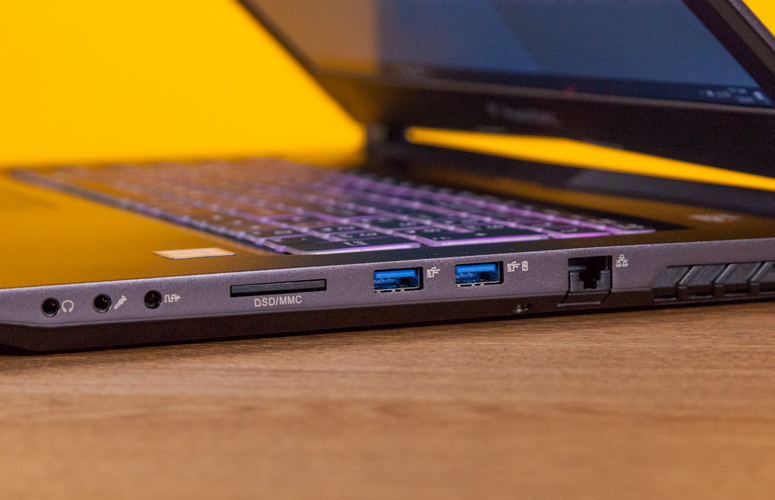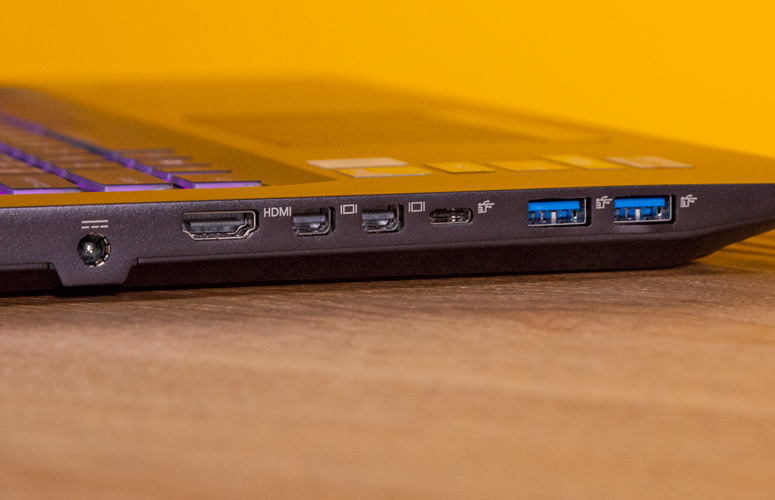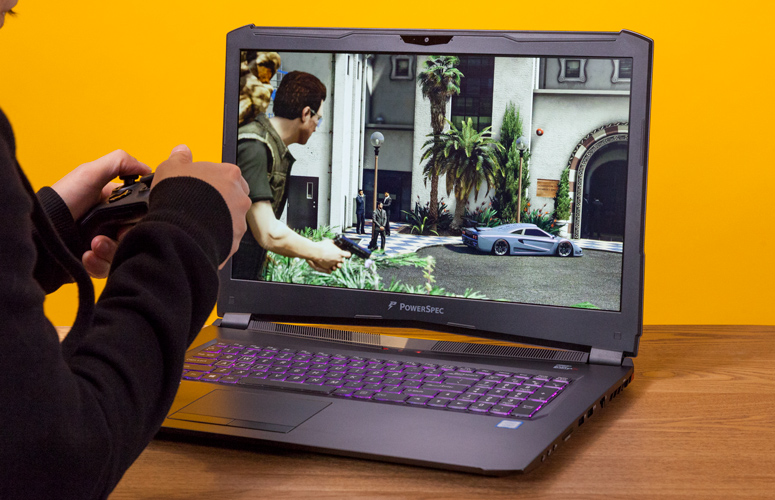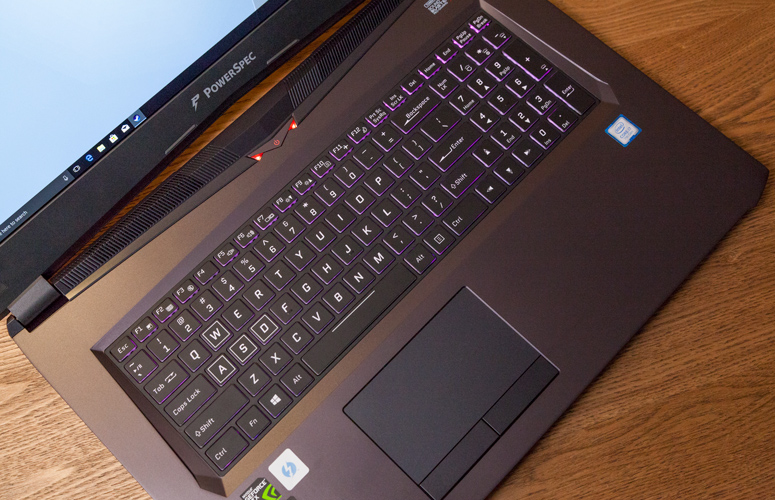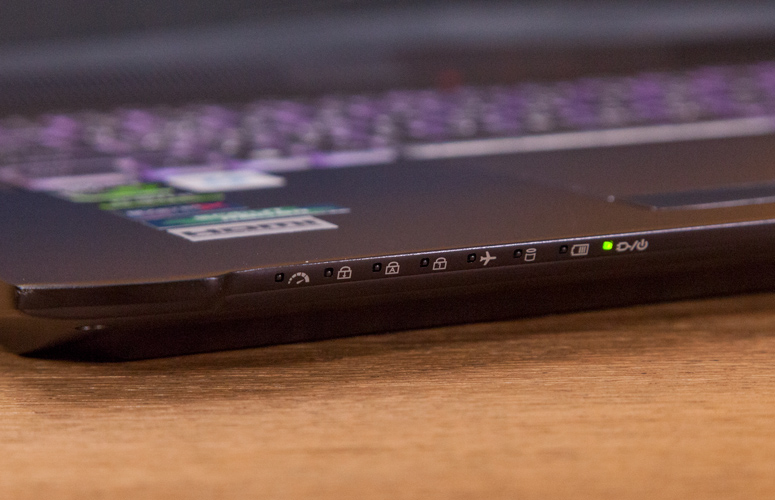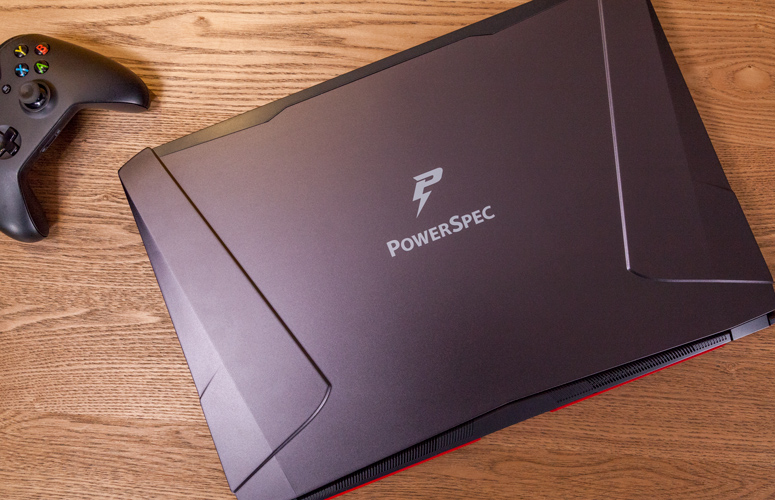Laptop Mag Verdict
The PowerSpec 1710 is a great deal on a GTX 1070, but the keyboard is uncomfortable and the audio is poor.
Pros
- +
Good price for a GTX 1070
- +
Vibrant display
- +
Solid battery life
Cons
- -
Poor audio quality
- -
Uncomfortable keyboard
Why you can trust Laptop Mag
I'm sure you've noticed that gaming laptops, especially ones with high-end graphics cards, are pricey. But the PowerSpec 1710, exclusively sold at Micro Center, looks like a sweet deal at just $1,399.99, with Nvidia GTX 1070 graphics inside..For the most part,, this is a solid, 17-inch gaming laptop with impressive power, if you can handle shortcomings such as an uncomfortable keyboard and poor audio output. But, hey, you might be able to put up with these trade-offs for the price.
Design
The PowerSpec manages to announce its gaming cred not only with a stereotypical red and dark-gray color scheme, but also with aggressive curves and edges. The chassis appears to be built by a third-party vendor -- perhaps Clevo -- though I haven't identified a specific model. Either way, no one will mistake this for a business notebook.
The aluminum lid features PowerSpec's logo in gray. Two raised curves make it look a bit like a spaceship. On the rear of the device, red plastic grills cover the fans.
The looks are decidedly less exciting on the inside. It's all black, with the exception of two red lights flanking the power button right beneath the 17.3-inch, 1080p display. The island-style keyboard and its RGB backlighting also give a touch of color. The screen is surrounded by a thick bezel, and the inward-pointing bottom is awkward; leaving a space that caught my eye and took me out of my immersion while I was using it.
At 6.8 pounds and an inch thick, the PowerSpec is smaller and lighter than its competitors: the Acer Aspire V 17 Nitro Black Edition (7 pounds, 1 inch thick), HP Omen 17 (8.2 pounds, 1.3 inches thick) and Lenovo Legion Y920 (10.1 pounds, 1.4 inches thick).
The PowerSpec has more ports that I can imagine any reasonable person using. The left side has an HDMI output, a pair of Mini DisplayPorts, Thunderbolt 3 and two USB 3.0 ports. On the right side of the chassis are a lock slot, Ethernet jack, another pair of USB 3.0 ports, an SD card slot and individual headphone, and microphone and optical audio jacks.
Sign up to receive The Snapshot, a free special dispatch from Laptop Mag, in your inbox.
Display
The 17.3-inch, 1080p screen on the PowerSpec is luminous and vivid, so games and media will look excellent on it. I watched the trailer for Avengers: Infinity War, and Spider-Man's new armor looked great; the red popped against the darker black sections. In another scene, I could clearly see all of the sweat and grime on Loki's face. Yuck.
The screen also looked good when I played Middle-Earth: Shadow of War; it's bright, and the Orcs' green flesh was bright, especially when surrounded by muddy, swampy forts. I could even make out detailed layers of leather in enemy armor.
The panel covers 119 percent of the sRGB color gamut, which is generally a great number, though the average for desktop replacements is a bit higher, at 129 percent. It ties the Legion (119 percent) and beats the Aspire (118 percent), but the Omen was the most vibrant of the group at 176 percent.
MORE: The Best Laptops for Business and Productivity
The display measured 372 nits of brightness, surpassing the average (288 percent) and the rest of the field: the Aspire (264 nits), Omen (300 nits) and Legion (362 nits).
Keyboard and Touchpad
The PowerSpec offers a mediocre 1.4 millimeters of travel, and it really doesn't feel good. Between that and the 66 grams of actuation necessary to press a key, the whole thing felt flat, and the membrane switches offered little to no feedback.
That shallowness often made me bottom out. On the 10fastfingers.com typing test, I hit 107 words per minute (the bottom of my usual range), but with a very high 8 percent error rate.
The 4.3 x 2.5-inch touchpad is smooth and accurate, though I found the buttons to be a little mushier than I would like. Still, it always responded to simple gestures like pinching-to-zoom and more complex ones, like swiping three fingers down to minimize all of my open programs.
Audio
The PowerSpec includes some software that claims to emulate 720-degree surround sound, but it sounded a lot like it was only going into my right ear. When I listened to The Who's "Water," the drums, intentionally twangy vocals, clashing cymbals and guitar were all clear, but I thought I was listening to a mono recording. The same thing happened for numerous other songs. Eventually, I turned the laptop over to find a subwoofer on only the right side of the bottom of the laptop. It was disorienting, but at least it was loud, filling our lab with wall-to-wall sound.
MORE: Best Music Apps for Rocking Out
The audio issues were magnified once I started gaming. When I played Middle-earth: Shadow of War, the orchestral background music blared out one side of the laptop, and rain pattering the dirt didn't sound like it surrounded me. Hearing which side an enemy is coming from can be the difference between victory and loss. At louder volumes, the speakers were shrieky. . I recommend getting a headset if you use this laptop.
The aforementioned software, Sound Blaster Connect, has presets for gaming, cinema, music concerts and even for specific video games like Battlefield 1, Overwatch and DOTA 2. But they all sounded similar, so I wouldn't recommend messing with it too much.
Gaming, Graphics and VR
With an Nvidia GeForce GTX 1070 GPU and 8GB of VRAM tucked inside, the PowerSpec 1710 does an admirable job playing the latest and greatest games. When I played Middle-earth: Shadow of War, the game ran between 76 and 94 frames per second on the very high preset and between 67 and 78 fps on ultra.
The computer ran the Hitman benchmark (108p, utra) at 60 fps, falling below the 82-fps average, the Omen (104 fps) and the Legion (107 fps), and just shy of the Aspire (62 fps) -- all of which have GTX 1070 GPUs.
On Rise of the Tomb Raider (1080p, Very High), it rendered at 55 fps, surpassing the 51-fps average, the Omen (52 fps) and the Aspire (37 fps). Only the Legion did better (59 fps).
MORE: The Best Gaming Laptops
During the Grand Theft Auto V test (1080p, Very High), it ran at 60 fps, falling behind the 65-fps average and the Legion (72 fps), but outperforming the Aspire (51 fps) and the Omen (58 fps).
Have an Oculus Rift or HTC Vive? Plug them right in. The PowerSpec did exceptionally well on the SteamVR Performance test, with a score of 10.9 (just shy of the max 11), beating the average (9.5), the Legion (10.6), the Omen (10.5) and the Aspire (7.2).
Performance
The PowerSpec 1710 comes armed with a 2.8-Ghz Intel Core i7-7700HQ CPU, 16GB of RAM, a 256GB NVMe SSD and a 1TB, 7,200-rpm HDD. With their powers combined, you get some strong performance. I had 25 tabs open, including one streaming a 1080p episode of "Last Week Tonight with John Oliver," without any slowdown at all.
On Geekbench 4, it earned a score of 14,138, which is higher than the desktop-replacement average (12,929), the Aspire (13,333, Core i7-7700HQ) and the Legion (14,051, Core i7-7820HK), but lower than the Omen (14,306, Core i7-7700HQ).
The PowerSpec took 13 seconds to copy 4.97GB of files, or 391.5 megabytes per second. That's slower than the average (438.6 MBps), as well as the Omen (565 MBps) and Legion (636.2 MBps), but speedier than the Aspire (231.3MBps).
It took the gaming laptop 3 minutes and 18 seconds to pair 20,000 names and addresses in the OpenOffice spreadsheet macro. That's faster than average (3:25) as well as the Legion (3:48) and Aspire (3:19). Only the Omen was quicker (3:13).
Battery Life
If you're lugging this 17 incher somewhere, you can feel safe knowing that it lasts slightly longer than its competitors. The PowerSpec ran for 5 hours and 55 minutes on the Laptop Mag Battery Test, which continuously browses the web over Wi-Fi. \
MORE: Laptops with the Longest Battery Life
That's longer than the desktop-replacement average (4:32) as well as the Omen (2:18), Legion (4:32) and Aspire (5:30).
Heat
This laptop stays nice and cool during everyday use. After streaming 15 minutes of HD video, the PowerSpec measured 85 degrees Fahrenheit on the underside, 82 degrees at the center of the keyboard and 77 degrees on the touchpad -- all well below our 96-degree comfort threshold.
But while I played Shadow of War, the bottom climbed to 122 degrees, the touchpad jumped to 80 degrees and the center of the keyboard reached 108 degrees.
Webcam
There's a 1080p embedded in the PowerSpec's top bezel, and it's pretty solid. In a photo I took in our office, it accurately captured the hairs on my head and even the varying shades of red in my colleague Mike's shirt, and he was sitting about 10 feet away.
In an environment with better lighting, you could consider streaming without an external webcam.
Software and Warranty
There isn't a ton of software included on the PowerSpec 1710, especially for a gaming laptop. The only meaningful gaming utility is called GameFeet, which combines macro recording, recording the frequency of key presses and controlling the RGB backlighting on the keyboard. Strangely, this wasn't listed in the start menu and had to be activated with a keyboard shortcut.
Otherwise, the preloaded software is all the bloat that you'll usually find with Windows 10, including Plex, Keeper, Drawboard PDF, Candy Crush Soda Saga, Bubble Witch 3 Saga and March of Empires: War of Lords.
The PowerSpec 1710 is available only at Micro Center. The store sells the laptop with a one-year warranty.
Bottom Line
If you're looking for a great deal on a laptop with a GTX 1070 GPU, the PowerSpec 1710 is worth a serious look, as other laptops with the same GPU can cost a few hundred dollars more.
But there's a reason you're getting that relatively low price. The PowerSpec has some sharply cut corners and it's not from a major gaming laptop manufacturer. The ill-placed subwoofer makes for one-sided sound and the keyboard is uncomfortable to use. You do, however, still get an awesome screen.
If you're looking for a better gaming laptop in this price range, your next best bet is the Acer Aspire V17 Nitro Black Edition, which you can buy for $1,269, but you'll get the GeForce GTX 1060, which, while powerful and VR ready, is still a significant step down.
Otherwise, your best bet is the HP Omen 17, where a similar configuration will cost $1,700. But you will be boosted up to a 2TB HDD, 32GB of RAM and a GTX 1070.
If you can live with its drawbacks, though, the PowerSpec 1710 gives you GTX 1070 graphics at a really good price.
Credit: Shaun Lucas/Laptop Mag
- Best Dell and Alienware Laptops
- Our Favorite Gaming Keyboards
- Our Favorite Gaming Mice for Every Genre
PowerSpec 1710 Specs
| Bluetooth | Bluetooth 4.1 |
| Brand | PowerSpec |
| CPU | 2.8-GHz Intel Core i7-7700HQ CPU |
| Card Slots | SD memory reader |
| Company Website | http://powerspec.com/ |
| Display Size | 17.3 |
| Graphics Card | NVIDIA GeForce GTX 1070 / 8GB |
| Hard Drive Size | 256GB |
| Hard Drive Type | NVMe SSD |
| Highest Available Resolution | 1920 x 1080 |
| Native Resolution | 1920x1080 |
| Operating System | Windows 10 Home |
| Ports (excluding USB) | Lock Slot, USB 3.0, Headphone, Thunderbolt 3, HDMI, SD card slot, Ethernet, Optical audio, Mini DisplayPort, Microphone |
| RAM | 16GB |
| Secondary Hard Drive Size | 1TB |
| Secondary Hard Drive Speed | 7200RPM |
| Secondary Hard Drive Type | SATA Hard Drive |
| Size | 16.5 x 11.5 x 1.0 inches |
| Touchpad Size | 4.3 x 2.5 |
| USB Ports | 5 |
| Video Memory | 8GB |
| Warranty/Support | 1-year |
| Weight | 6.8 pounds |
| Wi-Fi | 802.11ac |
| Wi-Fi Model | Intel Dual Band Wireless-AC 8265 |
Andrew is a contributing writer at Laptop Mag. His main focus lies in helpful how-to guides and laptop reviews, including Asus, Microsoft Surface, Samsung Chromebook, and Dell. He has also dabbled in peripherals, including webcams and docking stations. His work has also appeared in Tom's Hardware, Tom's Guide, PCMag, Kotaku, and Complex. He fondly remembers his first computer: a Gateway that still lives in a spare room in his parents' home, albeit without an internet connection. When he’s not writing about tech, you can find him playing video games, checking social media and waiting for the next Marvel movie.


